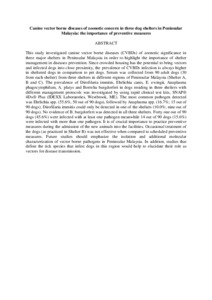Citation
Lau, Seng Fong and Dolah, R. N. and Mohammed, K. and Watanabe, Malaika and Megat Abdul Rani, Puteri Azaziah
(2017)
Canine vector borne diseases of zoonotic concern in three dog shelters in Peninsular Malaysia: the importance of preventive measures.
Tropical Biomedicine, 34 (1).
pp. 72-79.
ISSN 0127-5720
Abstract
This study investigated canine vector borne diseases (CVBDs) of zoonotic significance in three major shelters in Peninsular Malaysia in order to highlight the importance of shelter management in diseases prevention. Since crowded housing has the potential to bring vectors and infected dogs into close proximity, the prevalence of CVBDs infection is always higher in sheltered dogs in comparison to pet dogs. Serum was collected from 90 adult dogs (30 from each shelter) from three shelters in different regions of Peninsular Malaysia (Shelter A, B and C). The prevalence of Dirofilaria immitis, Ehrlichia canis, E. ewingii, Anaplasma phagocytophilum, A. platys and Borrelia burgdorferi in dogs residing in three shelters with different management protocols was investigated by using rapid clinical test kits, SNAP® 4Dx® Plus (IDEXX Laboratories, Westbrook, ME). The most common pathogen detected was Ehrlichia spp. (55.6%, 50 out of 90 dogs), followed by Anaplasma spp. (16.7%; 15 out of 90 dogs). Dirofilaria immitis could only be detected in one of the shelters (10.0%; nine out of 90 dogs). No evidence of B. burgdorferi was detected in all three shelters. Forty one out of 90 dogs (45.6%) were infected with at least one pathogen meanwhile 14 out of 90 dogs (15.6%) were infected with more than one pathogen. It is of crucial importance to practice preventive measures during the admission of the new animals into the facilities. Occasional treatment of the dogs (as practiced in Shelter B) was not effective when compared to scheduled preventive measures. Future studies should emphasize the isolation and additional molecular characterization of vector borne pathogens in Peninsular Malaysia. In addition, studies that define the tick species that infest dogs in this region would help to elucidate their role as vectors for disease transmission.
Download File
![[img]](http://psasir.upm.edu.my/61039/1.hassmallThumbnailVersion/Canine%20vector%20borne%20diseases%20of%20zoonotic%20concern%20in%20three%20dog%20shelters%20in%20Peninsular%20Malaysia%20the%20importance%20of%20preventive%20measures.pdf)  Preview |
|
Text (Abstract)
Canine vector borne diseases of zoonotic concern in three dog shelters in Peninsular Malaysia the importance of preventive measures.pdf
Download (6kB)
| Preview
|
|
Additional Metadata
Actions (login required)
 |
View Item |

